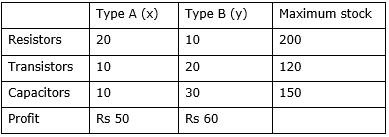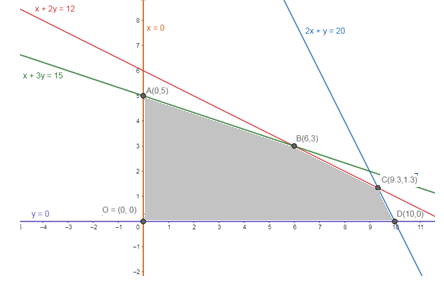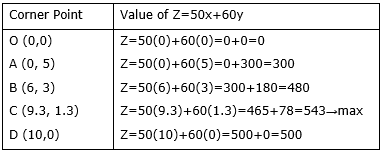Refer to Exercise 11. How many of circuits of Type A and of Type B, should be produced by the manufacturer so as to maximise his profit? Determine the maximum profit.
Referring to the exercise 11, we get following data
Let the manufacturer produces x units of type A circuits and y units of type B circuits. We make the following table from the given data:

Thus according to the table, the profit becomes, Z=50x+60y
Now, we have to maximize the profit, i.e., maximize Z=50x+60y
The constraints so obtained, i.e., subject to the constraints,
20x+10y≤ 200 [this is resistor constraint]
Now will divide throughout by 10, we get
⇒ 2x+y≤ 20…………..(i)
And 10x+20y≤ 120 [this is transistor constraint]
Now will divide throughout by 10, we get
⇒ x+2y≤ 12…………..(ii)
And 10x+30y≤ 150 [this is capacitor constraint]
Now will divide throughout by 10, we get
⇒ x+3y≤ 15…………..(iii)
And x≥0, y≥0 [non-negative constraint]
So, maximize profit, Z=50x+60y, subject to 2
x+y≤ 20
x+2y≤ 12
x+3y≤ 15
x≥0, y≥0
Now let us convert the given inequalities into equation.
We obtain the following equation
2x+y≤ 20
⇒ 2x+y= 20
x+2y≤ 12
⇒ x+2y= 12
x+3y≤ 15
⇒ x+3y= 15
x ≥ 0
⇒ x=0
y ≥ 0
⇒ y=0
The region represented by 2x+y≤ 20:
The line 2x+y=20 meets the coordinate axes (10,0) and (0,20) respectively. We will join these points to obtain the line 2x+y=20. It is clear that (0,0) satisfies the inequation 2x+y≤ 20. So the region that contain the origin represents the solution set of the inequation 2x+y≤ 20
The region represented by x+2y≤ 12:
The line x+2y=12 meets the coordinate axes (12,0) and (0,6) respectively. We will join these points to obtain the line x+2y=12. It is clear that (0,0) satisfies the inequation x+2y≤ 12. So the region that doesn’t contain the origin represents the solution set of the inequation x+2y≤ 12.
The region represented by x+3y≤ 15:
The line x+3y=15 meets the coordinate axes (15,0) and (0,5) respectively. We will join these points to obtain the line x+3y=15. It is clear that (0,0) satisfies the inequation x+3y≤ 15. So the region that contain the origin represents the solution set of the inequation x+3y≤ 15
Region represented by x≥0 and y≥0 is first quadrant, since every point in the first quadrant satisfies these inequations
The graph of these equations is given.

The shaded region OABCD is the feasible region is bounded, and maximum value will occur at a corner point of the feasible region.
Corner Points are O(0,0), A (0, 5), B (6, 3), C (9.3, 1.3) and D(10,0)
Now we will substitute these values in Z at each of these corner points, we get

So from the above table the maximum value of Z is at point (9.3, 1.3), but as the manufacturer is required to produce two type of circuits, so the parts of resistors, transistors and capacitors cannot be decimals. So we will consider the next maximum number.
Hence, the maximum value of Z is 480 at the point (6, 3) i.e., the manufacturer should produce 6 circuits of type A and 3 circuits of type B so as to maximize his profit.